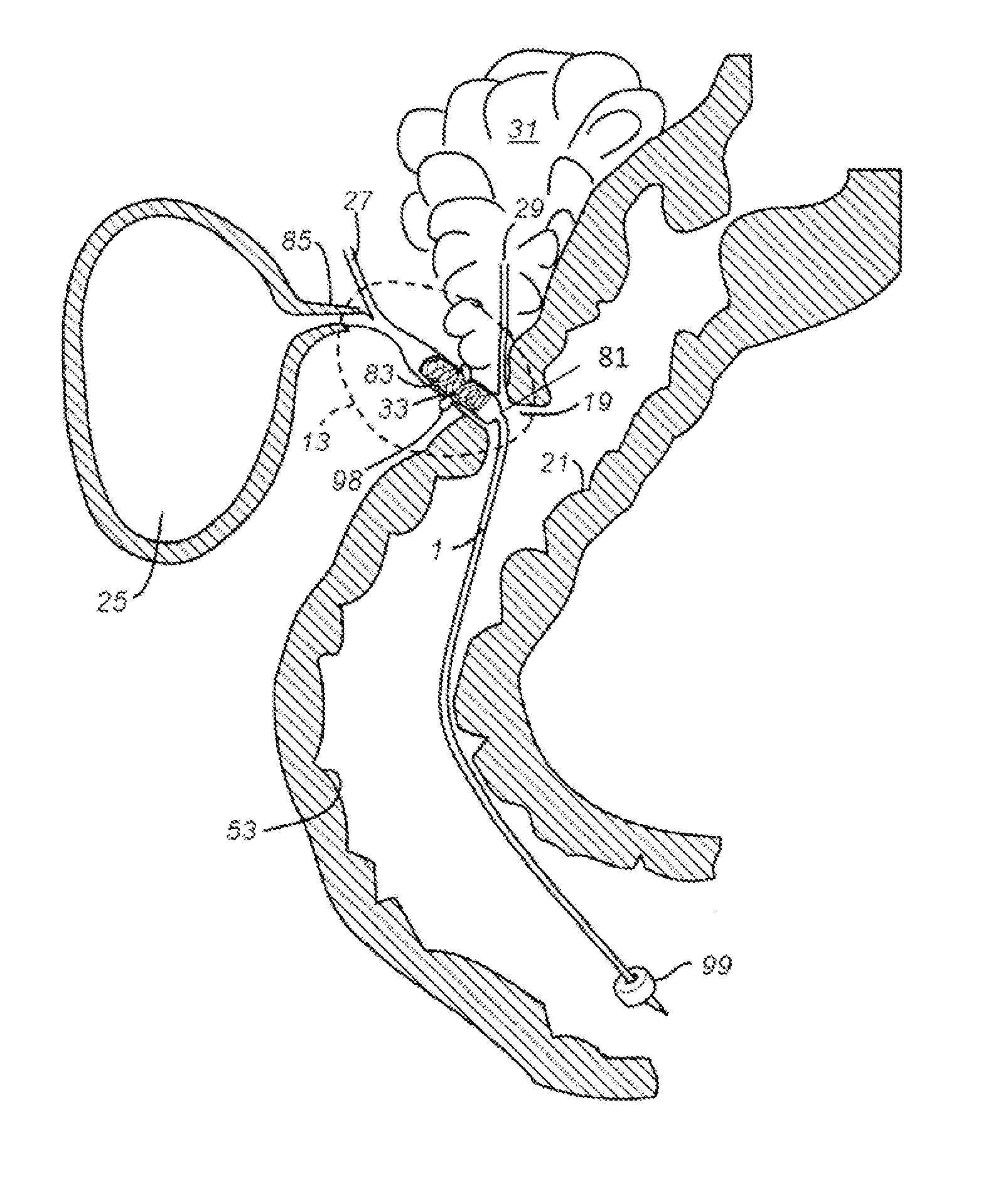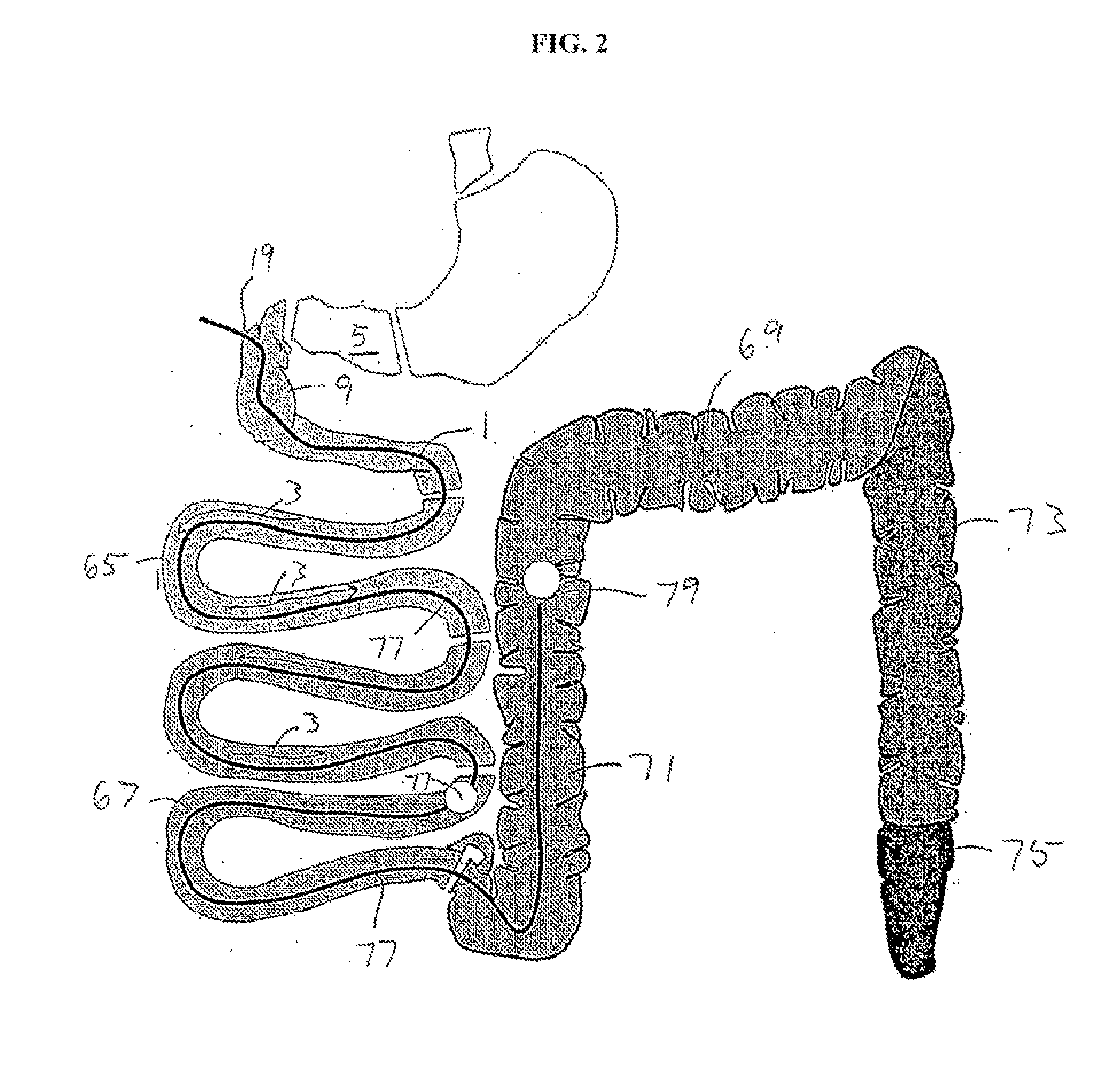Methods and Apparatus for Treating Obesity and Diabetes
a technology for obesity and diabetes, applied in the field of methods and apparatus for treating obesity and diabetes, can solve the problems of obesity and diabetes high mortality rates, significant economic costs, and withdrawal from the market, and achieve the effect of reducing the aggregation of particulate matter
- Summary
- Abstract
- Description
- Claims
- Application Information
AI Technical Summary
Benefits of technology
Problems solved by technology
Method used
Image
Examples
example 1
[0109]According to one clinical example, the effect of exogenous intraduodenal bile salt infusion on food intake and body weight was studied. Rats were surgically implanted with a catheter that passed from the peritoneal cavity to the lumen of the mid-duodenum and was held in place with a purse string suture and tissue adhesive. The peritoneal end of the catheter was connected to a mini-osmotic pump Alzet 2ML1 that delivered vehicle (controls; n=6), or solutions of taurocholic acid (150 mM (n=6) or 500 mM (n=7)) at a rate of 10 μL / hr for 1 week. The minipumps were primed for 24 hours before implantation, so the solution was therefore delivered into the duodenum for 6 days before the pumps stopped infusing. Relative to control rats, those infused with bile acid showed a reduction in food intake and in body weight, when expressed as a fraction of values prior to infusion. FIGS. 4A and 413 show this graphically. (label drawings with 4A and 4B)
[0110]FIG. 4A is a graphical illustration 2...
example 2
Choledocho-Jejunal-Ileum Bile Diversion Reduces Body Weight, Food Intake, and Fasting Glucose on DIO Rats
[0111]Experimental studies on rats were performed to investigate the optimal location within the intestine for delivery of bile for reduction of body weight, reduction of food intake, and reduction of fasting glucose levels.
[0112]Experiments involved development of surgical technique enabling to insert a polyethylene (PE) catheter anchored into the common bile duct to receive only bile and its distal end inserted and anchored into the four distinct areas of the intestine.
[0113]a. proximal jejunum
[0114]b. proximal ileum
[0115]c. mid-distal ileum
[0116]d. control (“Legend” or “Sham”)
[0117]Rats randomized to bile diversion (BD), or sham surgery (SET) were fed high-fat diet before and after surgery.
[0118]Endpoints.
[0119]Effects on food consumption, weight loss and on improvement of glycerine control were evaluated in duration of 2.5 weeks. Following parameters were tested before and af...
example 3
[0125]Exemplary devices and delivery devices are described below.
[0126]FIG. 8A is an illustrative view showing the present embodiment residing in the common bile duct and extending into the jejunum. The illustrative view also shows the relative positions of other organs within the peritoneal cavity. Each of the numbered items is described as follows: 1. Bile ducts, 2. Intrahepatic bile duets, 3. Left and right hepatic ducts. 4. Common hepatic duct, 5. Cystic duct, 6. Common bile duct, 7. Ampulla of Vater, 8. Major duodenal papilla, 9. Gallbladder, 10-11. Right and left lobes of liver, 12. Spleen, 13. Esophagus, 14. Stomach, Small intestine, 15. Duodenum, 16. Jejunum. 17. Pancreas, 18: Accessory pancreatic duct, 19: Pancreatic duct, 20-21: Right and left kidneys (silhouette), 22, Biliary Shunt.
[0127]FIG. 8B graphically shows the relative lengths of regions of the small intestine starting, at the duodenum and extending to the jejunum and ileum.
[0128]FIGS. 9 to 11 show schematic views ...
PUM
 Login to View More
Login to View More Abstract
Description
Claims
Application Information
 Login to View More
Login to View More - R&D
- Intellectual Property
- Life Sciences
- Materials
- Tech Scout
- Unparalleled Data Quality
- Higher Quality Content
- 60% Fewer Hallucinations
Browse by: Latest US Patents, China's latest patents, Technical Efficacy Thesaurus, Application Domain, Technology Topic, Popular Technical Reports.
© 2025 PatSnap. All rights reserved.Legal|Privacy policy|Modern Slavery Act Transparency Statement|Sitemap|About US| Contact US: help@patsnap.com



